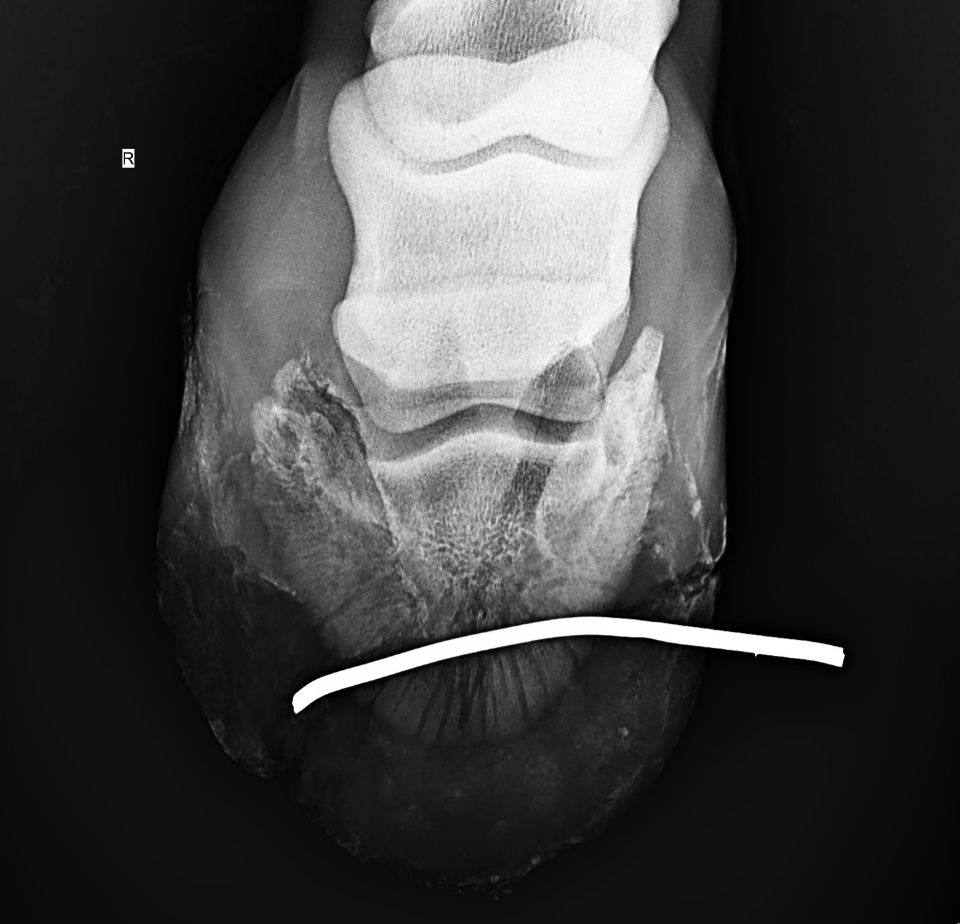Back From The Brink: Dr. Santiago Demierre Gives Peachy a Second Chance
February 18, 2020 - Wellington, FL
Photo courtesy of PBEC
Photo courtesy of PBEC
Photo by Erin Gilmore Photography
When two-year-old Quarter Horse filly Peachy decided to jump out of her paddock for a night-time stroll this past November, she got herself into some creative “young horse” trouble. After tipping over a garbage can containing bailing wire, she became entangled in the wire and her attempts to kick free resulted in the wire penetrating the wall of her right hind hoof and looped through the sole. The more the filly kicked, the deeper the wire went until it pierced the opposite side of the hoof wall and protruded out the other side.
The first call owner Corey Chilcutt made was to the clinic, and on-call veterinarian Dr. Santiago Demierre responded immediately.
“When I arrived, the two ends of wire that looped over the horse’s back had been cut down so it was only the wire penetrating the hoof,” said Dr. Demierre. “She was stressed and in a great deal of pain. I sedated the horse and blocked the foot so she would not feel any more pain.”
Once Peachy, who is in training to run barrels in Loxahatchee, FL, was comfortable, Dr. Demierre utilized portable radiograph technology to obtain x-ray images of the right hind foot and evaluate the injury. The images revealed that it was safe to remove the wire, and after disinfecting the area, Dr. Demierre removed the wire through the injury site.
“There were no fractures or synovial structures involved, but I did see on the radiograph that the coffin bone was compromised,” said Dr. Demierre. “There was a suspicious line through the coffin bone that could have led to chronic lameness, so the prognosis for performance was reserved. The prognosis for survival was very positive, and I told the owner there was a 50/50 chance she would return to training.”
Once Peachy’s hoof was free from the wire, Dr. Demierre soaked the foot in disinfectant, and began an aggressive course of antibiotic treatments, including regional distal limb perfusion and systemic antibiotics. Finally, the foot was wrapped while the treatments did their work.
Dr. Demierre returned to check on Peachy and continue the antibiotic treatments six times over the next two months. “I performed recheck radiographs of the hoof a month after the injury and there was no fracture where we saw the initial line that caused concern,” said Dr. Demierre. “The margins of the coffin bone had reabsorbed slightly, but overall the injury was healing well.”
Once the bandages were removed, Dr. Demierre worked with Chilcutt’s farrier, Juan Rivera, on a therapeutic shoeing plan. Rivera used a hospital plate with disinfectant on the injured hoof, and a bar shoe with a pour-in pad on the opposite hind hoof. At the first shoeing reset a month later, he transitioned the right hoof to a bar shoe with a pour-in pad.
Peachy’s recovery plan included stall rest until Dr. Demierre gave the green light for hand walking six weeks after the injury. At eight weeks, she was trotting on a lunge line, and earlier this month Peachy’s rider Kloey sat on her for the first time.
“The outcome was excellent,” said Dr. Demierre. “She is perfectly sound with no medication and will be back in normal shoes by the end of this month.”
Chilcutt is hopeful that Peachy and Kloey will return to their training and will be running barrels in the future. “Dr. Demierre was amazing; his treatment plan was successful and Peachy was back to work much quicker than we ever thought. Words can’t describe the gratitude we have for Dr. Demierre, his technician Emma Sexton, and everyone at the clinic. Their dedication has been phenomenal.”
As of February 14, Peachy is back to her old self, according to Chilcutt, who noted, “She is happy to be back to work and she loves her job!”
Learn More about Dr. Santiago Demierre HERE.








